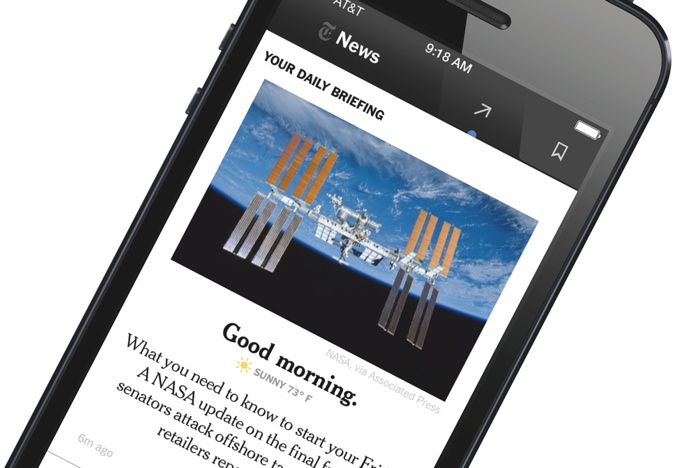
This week’s essential reads: If you’re short on time, the key pieces this week are Ken Doctor’s analysis of Project Thunderdome’s shutdown, Joshua Benton’s review of the new NYT Now, and Alex Howard’s interview with The New York Times’ Aron Pilhofer about data journalism.
Thunderdome and the long, hard road for local news: The newspaper chain Digital First Media shut down its ambitious Project Thunderdome this week, a stinging reminder of the difficulties in large-scale digital media innovation within local newspapers. Thunderdome, which was launched three years ago as a digitally savvy centralized news production site for Digital First’s 75 papers, was shut down as part of larger cuts at the company, with about 50 Thunderdome employees laid off.
Digital First CEO John Paton said some of what Thunderdome did would be discontinued, and some would be distributed among Digital First’s papers. Poynter’s Jill Geisler gave a sense of the mood in the newsroom, and one of Thunderdome’s journalists, Steve Buttry, said the project didn’t fail because “you can’t fail unless you were given a chance to succeed.”
USA Today’s Rem Rieder focused on the schadenfreude that others in the news industry were reportedly feeling over Thunderdome’s demise, based on their perception of Paton as a digital-media showman with more brash style than actual solutions. But the Lab’s Ken Doctor, in the most thorough analysis of the shutdown, argued that while Thunderdome’s demise is a bitter pill for Paton, his overall transformation efforts at Digital First have been impressive: “Paton parlayed a small hand on a way-down-on-the-food-chain (Journal Register Co.) into a major U.S. digital news company.” Likewise, Gigaom’s Mathew Ingram saw the shutdown not as a failure, but simply as an indication of how tough it is to reinvent a newspaper company, and J-Source’s Melanie Coulson praised Digital First for its digital experimentation and called for more.
A few observers tried to pinpoint exactly what sunk Thunderdome. Rick Edmonds of Poynter highlighted the chain’s outdated technology with which the project had to work, exemplified by its widely varying and clunky set of content management systems. Media analyst Alan Mutter focused on Digital First’s owners, the hedge fund investors of Alden Capital Investors. “The objectives of the Digital First investors were the antithesis of the patience — and multimillion-dollar commitment — required in the slog to identify successful interactive publishing models,” Mutter wrote. Journalism professor Dan Kennedy made a similar point while looking at Digital First’s New Haven Register, wondering if local journalism can really be reinvented by a company owned by a hedge fund.

Facebook chokes off brands’ reach: The tech world has been talking for a couple of weeks about reports that Facebook is cutting the amount of reach brands can get with their posts, forcing them to pay if they want to reach more than just a small percentage of their fans. One company, the food delivery service Eat24, complained about the change in an post announcing it planned to delete its Facebook page. Facebook responded with a retort of its own saying that it’s not showing its readers content that they’ve shown they don’t care about, though Recode’s Mike Isaac said Eat24 has a valid point, and The New York Times’ Vindu Goel said its concerns are quietly being echoed by many other, larger companies.
Gigaom’s Mathew Ingram said the change reinforces the distinction between Twitter’s flood of information and Facebook’s carefully controlled stream, and the notion that Facebook isn’t the kind of social network we’ve assumed it was: “It is not an open platform in which content spreads according to its own whims: like a newspaper, Facebook controls what you see and when.”
At Recode, marketing executive Michael Lazerow defended Facebook, arguing that companies are naive to expect free distribution from Facebook forever, and they need to respond by making their posts more relevant and spreadable. On the other side, Dijit Media president Jeremy Toeman argued that when Facebook users like a page, they expect to get that page’s updates. He urged Facebook to disclose to users that they won’t see every update when they like a page and to give them an option to subscribe to all of a page’s updates.

NYT Now launches: NYT Now, The New York Times’ much anticipated (or at least much promoted) news digest and aggregation app, launched this week. The Lab’s Ken Doctor analyzed the Times’ business strategy behind the app, looking at who’s going to subscribe at an $8-a-month rate. The Atlantic’s Robinson Meyer expressed his excitement at the idea that NYT Now is trying to reward regular readers with a single, contained news package rather than a stream of news to dip in and out of.
The Lab’s Joshua Benton gave the app a mostly positive review, noting that its stories (and story selection) closely resemble the Times’ main product, but its aggregation and voice are a new arena for the paper. “Here’s hoping that the DNA of NYT Now can spread back into the core apps and that it can push harder at bringing an experimental edge to sharing great Times content with the world,” he wrote. Poynter’s Sam Kirkland also noted that NYT Now isn’t emphasizing breaking news and suggested that readers will switch back and forth between NYT Now and the main app.
Reading roundup: A few other stories to catch up on during a relatively slow week:
— The mobile analytics company Flurry published a set of data on use of apps vs. mobile browsers, concluding that the former have left the latter in the dust. Poynter’s Sam Kirkland said the mobile web is still very much alive for news, while BuzzFeed’s Charlie Warzel said the data help explain Facebook’s recent purchase of WhatsApp.

— Local billionaire Glen Taylor signed a letter of intent on a cash offer to buy the Minneapolis Star Tribune from the two investment firms that currently own most of the paper’s shares. Fellow Minnesotan David Carr of The New York Times reflected on the Star Tribune that was and its prospects with Taylor in charge.
— A few fantastic pieces on data journalism: The Tow Center for Digital Journalism conducted illuminating interviews with The New York Times’ Aron Pilhofer and NPR’s Jeremy Bowers. And at Source, Jeremy Merrill and Sisi Wei offered a very useful guide to getting a job in journalism and coding.